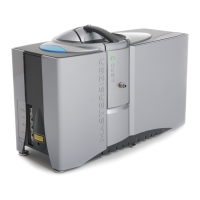Maintenanc e
84
Cell windows — cleaning procedures
Follow these guidelines to clean the windows of the dispersion units.
Note: The cell window faces must not be touched directly during the removal
and replacement procedure. Lens tissues should be placed over the window
faces where necessary. Use standard laboratory gloves in all cell seals, cell cover
plates and cell windows maintenance procedures. Malvern recommends dis-
posable, powder free, nitrile gloves.
General guidelines
Keep optical components as clean as possible to prevent additional light scattering from
dust particles affecting your measurement.
When optical components have been used for a long period of time, assume that they
need to be cleaned. As they are also very expensive, take a careful approach, use minimal
pressure against the surface of the windows to avoid scratches.
When cleaning a window:
l Take all precautions to avoid grease from fingers being transferred to the surface.
l Make sure only tissue comes into contact with the surface. Do not apply too much
pressure as grit may scratch the window.
l Never use rubber gloves to hold the window. These invariably contain oils and
short chain polymers which can be harder to remove than finger smears.
Caution!
Silicone oils adhere strongly to glass; if deposited on the glass surface the com-
ponent will be ruined.
Cleaning steps
Depending upon the quality and cleanliness of the windows, use the appropriate tech-
niques to clean as described. Read through each step to determine the correct techniques
required; these are described in order of severity and contamination.
Inspect the cell window in reflected light from a fluorescent light or other light source.

